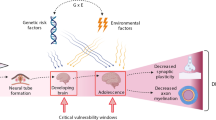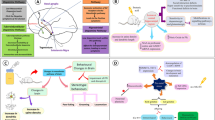Abstract
Autism spectrum disorders (ASD) are a highly heterogeneous group of neurodevelopmental disorders caused by complex interaction between various genes and environmental factors. As the hippocampus and prefrontal cortex are involved in social recognition, they are the regions of the brain implicated in autism. The effects of prenatal exposure to valproic acid (VPA) can induce an ASD phenotype in both humans and rats; this tool is commonly used to model the complexity of ASD symptoms in the laboratory. However, researchers rarely undertake epigenetic regulation of the brain regions using this model. The present study has addressed this gap by examining gene expression abnormalities in the hippocampus and prefrontal cortex in the VPA rat model of ASD. mRNA and miRNA sequencing was performed on samples from the hippocampus and prefrontal cortex of the VPA model of autism. According to the analysis, 3000 mRNAs in the hippocampus and 2187 mRNAs in the prefrontal cortex showed a significant difference in expression between the VPA and saline groups. In addition, there were 115 DE miRNAs in the hippocampus and 14 DE miRNAs in the prefrontal cortex. Further, the predicted and validated target mRNA of DE miRNA enriched pathways involved neurotransmitter uptake, long-term synaptic depression, and AMPA receptor complex (anti-GluA2-b) in the hippocampus; as well as the neuroactive ligand–receptor interaction and regulation of postsynaptic membrane potential in the prefrontal cortex. This revealed the negative regulation network of miRNAs–mRNAs in the hippocampus and prefrontal cortex, while filtering out key genes (miR-10a-5p and Grm3). Finally, the significant variable miR-10a-5p and its negative regulated genes (Grm3) were verified in both brain regions by QPCR. Importantly, the fact that miR-10a-5p downregulated Grm3 in both the hippocampus and the prefrontal cortex may play a potentially significant role in the occurrence and development of autism. This study suggests that the VPA model has the potential to reproduce ASD-related hippocampus and prefrontal cortex abnormalities, at the epigenetic and transcriptional levels. Furthermore, the network of miRNAs–mRNAs was confirmed; this negative regulatory relationship may play a key role in determining the occurrence and development of autism. The study of this topic help better understand the pathogenesis of ASD.




Similar content being viewed by others
Data Availability
Data and materials were available upon request.
References
Lai MC, Lombardo MV, Baron-Cohen S (2014) Autism. Lancet 383(9920):896–910
Chen L, Shi XJ, Liu H, Mao X, Gui LN, Wang H, Cheng Y (2021) Oxidative stress marker aberrations in children with autism spectrum disorder: a systematic review and meta-analysis of 87 studies (N = 9109). Transl Psychiatry 11(1):15
Du Y, Chen L, Yan MC, Wang YL, Zhong XL, Xv CX, Li YB, Cheng Y (2023) Neurometabolite levels in the brains of patients with autism spectrum disorders: a meta-analysis of proton magnetic resonance spectroscopy studies (N = 1501). Mol Psychiatry. https://doi.org/10.1038/s41380-023-02079-y
de la Torre-Ubieta L, Won H, Stein JL, Geschwind DH (2016) Advancing the understanding of autism disease mechanisms through genetics. Nat Med 22(4):345–361
Gupta S, Ellis SE, Ashar FN, Moes A, Bader JS, Zhan J, West AB, Arking DE (2014) Transcriptome analysis reveals dysregulation of innate immune response genes and neuronal activity-dependent genes in autism. Nat Commun 5:5748
Zhang R, Zhou J, Ren J et al (2018) Transcriptional and splicing dysregulation in the prefrontal cortex in valproic acid rat model of autism. Reprod Toxicol 77:53–61
Provenzano G, Corradi Z, Monsorno K, Fedrizzi T, Ricceri L, Scattoni ML, Bozzi Y (2016) Comparative gene expression analysis of two mouse models of autism: transcriptome profiling of the BTBR and En2 (-/-) hippocampus. Front Neurosci 10:396
Williams G, King J, Cunningham M, Stephan M, Kerr B, Hersh JH (2001) Fetal valproate syndrome and autism: additional evidence of an association. Dev Med Child Neurol 43(3):202–206
Williams PG, Hersh JH (1997) A male with fetal valproate syndrome and autism. Dev Med Child Neurol 39(9):632–634
Narita N, Kato M, Tazoe M, Miyazaki K, Narita M, Okado N (2002) Increased monoamine concentration in the brain and blood of fetal thalidomide- and valproic acid-exposed rat: putative animal models for autism. Pediatr Res 52(4):576–579
Wang R, Tan J, Guo J, Zheng Y, Han Q, So KF, Yu J, Zhang L (2018) Aberrant development and synaptic transmission of cerebellar cortex in a VPA induced mouse autism model. Front Cell Neurosci 12:500
Schiavi S, Iezzi D, Manduca A et al (2019) Reward-related behavioral, neurochemical and electrophysiological changes in a rat model of autism based on prenatal exposure to valproic acid. Front Cell Neurosci 13:479
Nicolini C, Fahnestock M (2018) The valproic acid-induced rodent model of autism. Exp Neurol 299:217–227
Tartaglione AM, Schiavi S, Calamandrei G, Trezza V (2019) Prenatal valproate in rodents as a tool to understand the neural underpinnings of social dysfunctions in autism spectrum disorder. Neuropharmacology 159:107477
Du Y, Yu Y, Hu Y et al (2019) Genome-wide, integrative analysis implicates exosome-derived microRNA dysregulation in schizophrenia. Schizophr Bull 45(6):1257–1266
Yu J, Wang S, Zhao W et al (2018) Mechanistic exploration of cancer stem cell marker voltage-dependent calcium channel alpha2delta1 subunit-mediated chemotherapy resistance in small-cell lung cancer. Clin Cancer Res 24(9):2148–2158
Robinson MD, McCarthy DJ, Smyth GK (2010) edgeR: a Bioconductor package for differential expression analysis of digital gene expression data. Bioinformatics 26(1):139–140
Wei ZX, Xie GJ, Mao X, Zou XP, Liao YJ, Liu QS, Wang H, Cheng Y (2020) Exosomes from patients with major depression cause depressive-like behaviors in mice with involvement of miR-139–5p-regulated neurogenesis. Neuropsychopharmacology 45(6):1050–1058
Du Y, Li XS, Chen L, Chen GY, Cheng Y (2020) A network analysis of epigenetic and transcriptional regulation in a neurodevelopmental rat model of schizophrenia with implications for translational research. Schizophr Bull 46(3):612–622
Zhou J, Zhang X, Ren J, Wang P, Zhang J, Wei Z, Tian Y (2016) Validation of reference genes for quantitative real-time PCR in valproic acid rat models of autism. Mol Biol Rep 43(8):837–847
Thongkorn S, Kanlayaprasit S, Jindatip D, Tencomnao T, Hu VW, Sarachana T (2019) Sex differences in the effects of prenatal bisphenol A exposure on genes associated with autism spectrum disorder in the hippocampus. Sci Rep 9(1):3038
Kanlayaprasit S, Thongkorn S, Panjabud P, Jindatip D, Hu VW, Kikkawa T, Osumi N, Sarachana T (2021) Autism-related transcription factors underlying the sex-specific effects of prenatal bisphenol A exposure on transcriptome-interactome profiles in the offspring prefrontal cortex. Int J Mol Sci 22(24):13201. https://doi.org/10.3390/ijms222413201
Zhao H, Wang Q, Yan T et al (2019) Maternal valproic acid exposure leads to neurogenesis defects and autism-like behaviors in non-human primates. Transl Psychiatry 9(1):267
Maynard KR, Collado-Torres L, Weber LM et al (2021) Transcriptome-scale spatial gene expression in the human dorsolateral prefrontal cortex. Nat Neurosci 24(3):425–436
OldeLoohuis NF, Kole K, Glennon JC et al (2015) Elevated microRNA-181c and microRNA-30d levels in the enlarged amygdala of the valproic acid rat model of autism. Neurobiol Dis 80:42–53
Casey JP, Magalhaes T, Conroy JM et al (2012) A novel approach of homozygous haplotype sharing identifies candidate genes in autism spectrum disorder. Hum Genet 131(4):565–579
Liu LJ, Sun XY, Yang CX, Zou XY (2021) MiR-10a-5p restrains the aggressive phenotypes of ovarian cancer cells by inhibiting HOXA1. Kaohsiung J Med Sci 37(4):276–285
Fei X, Jin HY, Gao Y, Kong LM, Tan XD (2020) Hsa-miR-10a-5p promotes pancreatic cancer growth by BDNF/SEMA4C pathway. J Biol Regul Homeost Agents May-Jun 34(3):927–934
Bao M, Pan S, Yang W, Chen S, Shan Y, Shi H (2018) Serum miR-10a-5p and miR-196a-5p as non-invasive biomarkers in non-small cell lung cancer. Int J Clin Exp Pathol 11(2):773–780
Worst TS, Previti C, Nitschke K, Diessl N, Gross JC, Hoffmann L, Frey L, Thomas V et al (2019) miR-10a-5p and miR-29b-3p as extracellular vesicle-associated prostate cancer detection markers. Cancers (Basel) 12(1):43. https://doi.org/10.3390/cancers12010043
Saini SM, Mancuso SG, Mostaid MS, Liu C, Pantelis C, Everall IP, Bousman CA (2017) Meta-analysis supports GWAS-implicated link between GRM3 and schizophrenia risk. Transl Psychiatry 7(8):e1196
Mounce J, Luo L, Caprihan A, Liu J, Perrone-Bizzozero NI, Calhoun VD (2014) Association of GRM3 polymorphism with white matter integrity in schizophrenia. Schizophr Res 155(1–3):8–14
Funding
This work was supported by the National Natural Science Foundation of China (82071676), Sichuan Provincial Natural Science Foundation Project (2022NSFSC0769).
Author information
Authors and Affiliations
Contributions
Y.C. conceived the study. L.C. and Y.C. designed the research. L.C. conducted the research and analyzed and interpreted the data. Y.C. drafted the manuscript with critical revisions from Q.F., Y.D., and ZY.J.
Corresponding authors
Ethics declarations
Ethics Approval
This study was approved by the Animal Care and Use Committee of Minzu University of China.
Informed Consent
This is not applicable.
Conflict of Interest
The authors declare no competing interests.
Additional information
Publisher's Note
Springer Nature remains neutral with regard to jurisdictional claims in published maps and institutional affiliations.
Supplementary Information
Below is the link to the electronic supplementary material.
Rights and permissions
Springer Nature or its licensor (e.g. a society or other partner) holds exclusive rights to this article under a publishing agreement with the author(s) or other rightsholder(s); author self-archiving of the accepted manuscript version of this article is solely governed by the terms of such publishing agreement and applicable law.
About this article
Cite this article
Chen, L., Fu, Q., Du, Y. et al. Transcriptome Analysis and Epigenetics Regulation in the Hippocampus and the Prefrontal Cortex of VPA-Induced Rat Model. Mol Neurobiol 61, 167–174 (2024). https://doi.org/10.1007/s12035-023-03560-z
Received:
Accepted:
Published:
Issue Date:
DOI: https://doi.org/10.1007/s12035-023-03560-z




